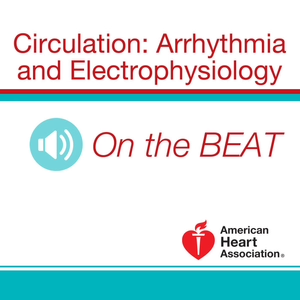
Circulation: Arrhythmia and Electrophysiology May 2019 Issue
Circulation: Arrhythmia and Electrophysiology On the Beat05/21/19 • 11 min
Dr Paul Wang: Welcome to the monthly podcast, On the Beat, for Circulation: Arrhythmia and Electrophysiology. I'm Dr Paul Wang, editor-in-chief, with some of the key highlights from this month's issue.
In our first article, Daniel Alyesh, Konstantinos Siontis and associates described myocardial calcifications in patients with ischemic cardiomyopathy undergoing ventricular tachycardia ablation in comparison to a control group of patients without ventricular tachycardia. They found that in 56 consecutive post-infarction patients, myocardial calcifications were identified in 39 or 70% of post-infarction ventricular tachycardia patients compared to 6 or 11% of patients without ventricular tachycardia. A calcification volume of 0.538 centimeters cube distinguished patients with calcification-associated ventricular tachycardia from patients without calcification-associated ventricular tachycardias; area under the curve, 0.87; sensitivity, 0.87; specificity, 0.88. A non-confluent calcification pattern was associated with ventricular tachycardia target sites independent of calcification volume, P equals 0.01. Myocardial calcifications corresponding to areas of electrical non-excitability forming a border for re-entry were found in 33% of all ventricular tachycardias for which target sites were identified, and in 62% of patients with myocardial calcifications.
In our next paper, Mia Fangel and associates examined whether glycemic status evaluated by hemoglobin A1c has an effect on the risk of thromboembolism among patients with atrial fibrillation and Type 2 diabetes. They used a cohort study from 5,386 patients with incident non-valvular atrial fibrillation and Type 2 diabetes in Danish registries. Compared with patients with hemoglobin A1c of less than or equal to 48 millimole per mole, they observed a higher risk of thromboembolism among patients with hemoglobin A1c 49 to 58 millimoles per mole with a hazard ratio of 1.49 and a hemoglobin A1c greater than 58 millimole per mole with a hazard ratio of 1.59 after adjusting for confounding factors. Surprisingly, in patients with diabetes duration of 10 years or more, higher hemoglobin A1c levels were not associated with a higher risk of thromboembolism.
In our next paper, Niek Beurskens and associates compared tricuspid valve dysfunction in leadless pacemaker therapy to dual chamber transvenous pacing systems. They studied 53 patients receiving a leadless pacemaker, including 28 with a Nanostim and 25 with a Micra device. Of these 53 patients, 23 or 43% had tricuspid regurgitation that was graded as being more severe at 12 months. Compared with an apical position, a right ventricular septal position of the leadless pacemaker was associated with increased tricuspid valve incompetence, odds ratio, 5.20; P equals 0.03. An increase in mitral valve regurgitation was observed in 38% of patients. Leadless pacemaker implantation resulted in a reduction of right ventricular function. Leadless pacemaker implantation was further associated with a reduction in left ventricular ejection fraction and elevated LV TI index. The changes in tricuspid regurgitation in leadless pacing group was similar to the changes in dual-chamber transvenous pacemaker group, 43% versus 38% respectively; P equals 0.39.
In our next paper, Jurgen Duchenne and associates examined whether regional left ventricular glucose metabolism correlates with regional work in an animal model with reversible dyssynchrony due to pacing. In 12 sheep, after 8 weeks of right atrial and right ventricular free wall pacing, there is evidence of left ventricular dilatation and thinning of the septum and thickening of the lateral wall. The authors employed motion compensation and anatomical correction in order to provide reliable regional estimates of myocardial glucose metabolism. They found that in homogenous regional distribution of myocardial workload due to left bundle branch block triggers adaptive remodeling of the left ventricle, leading to a more homogenous load distribution per volume unit myocardium. In reverse, cardiac resynchronization therapy leads acutely to an inhomogeneous distribution of workload, which homogenizes over time due to reverse remodeling. The authors concluded that redistribution of regional loading appears as a mode of action of cardiac resynchronization therapy so that myocardial mechanics should be the main treatment target of cardiac resynchronization therapy.
In our next paper, Jihye Jang and associates examined the association between local conduction velocity and late gadolinium enhancement and myocardial thickness in a swine model of healed left ventricular infarction. They studied six swine with healed myocardial infarction and two controls. The authors found a significantly slower conduction was found in late gadolinium enhancement regions, 0.33 versus 0.54 meters per second, P less than 0.001, and regions of wall thinning, 0.38 versus 0....
05/21/19 • 11 min
Episode Comments
0.0
out of 5
No ratings yet
eg., What part of this podcast did you like? Ask a question to the host or other listeners...
Post
Generate a badge
Get a badge for your website that links back to this episode
<a href="https://goodpods.com/podcasts/circulation-arrhythmia-and-electrophysiology-on-the-beat-94401/circulation-arrhythmia-and-electrophysiology-may-2019-issue-5066060"> <img src="https://storage.googleapis.com/goodpods-images-bucket/badges/generic-badge-1.svg" alt="listen to circulation: arrhythmia and electrophysiology may 2019 issue on goodpods" style="width: 225px" /> </a>
Copy